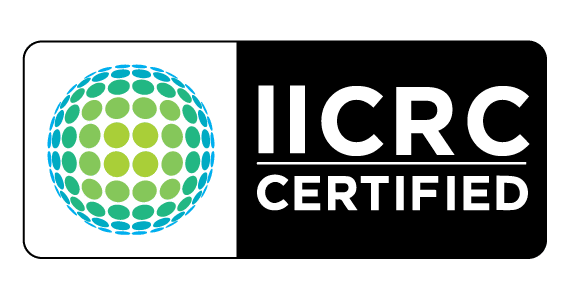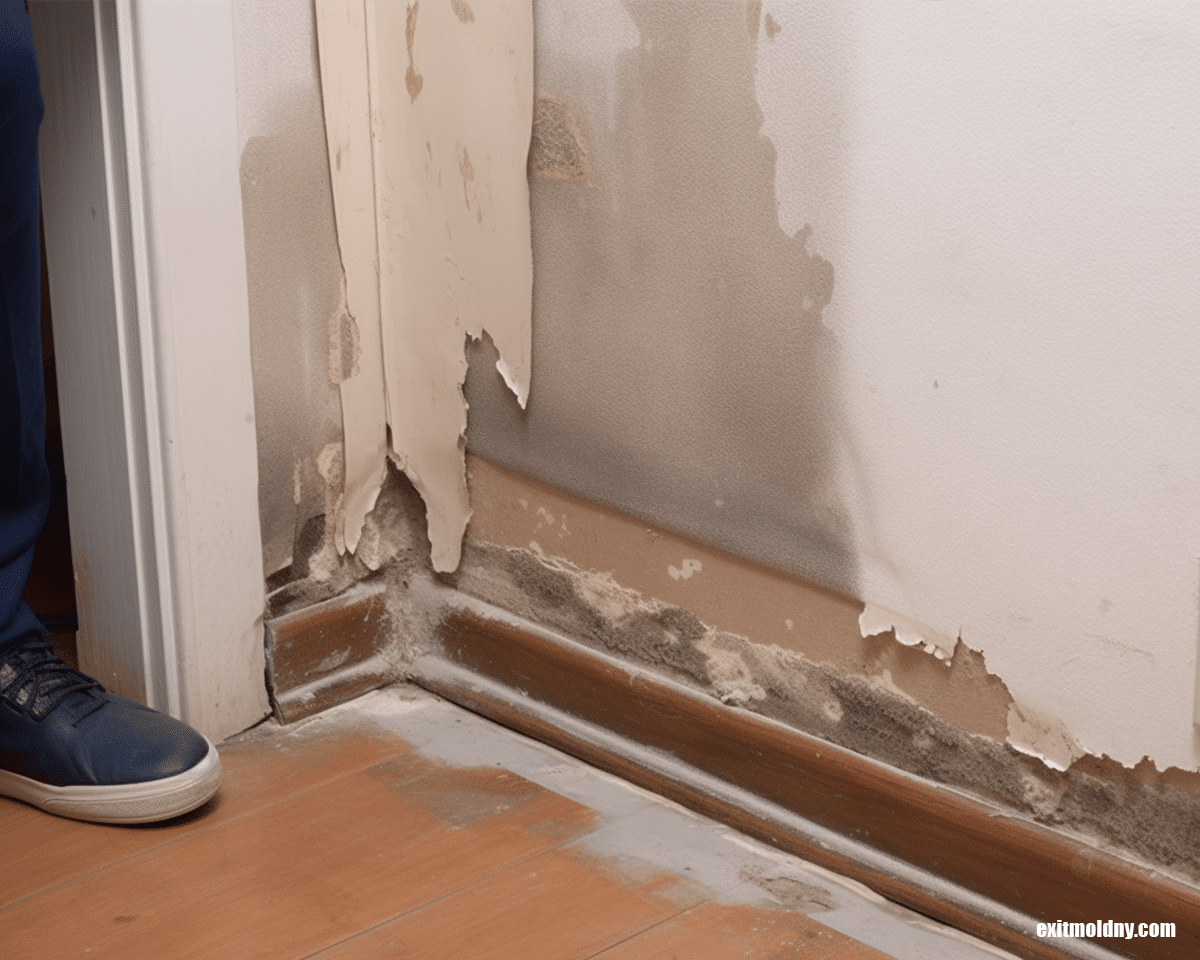
Restoring Your Home: Repairs and Renovations
Restoring Your Home: Repairs and Renovations In our blog, A Comprehensive Guide To Cleaning Up After A Flood, we wrote about physically cleaning a home
Flash flooding is a normal phenomenon in densely populated cities such as New York, with many buildings, highways, driveways, and asphalt or cement parking lots increasing water runoff by decreasing the amount of water absorbed into the ground. Flash flooding also occurs when streams are sometimes re-routed into storm drains clogged by debris. The low spots of underpasses, underground parking garages, subways, and basements are also easy targets for the raging flood waters.
No matter if an invasion of water is a few inches or a few feet — a flooded home or business is a costly nightmare that can bring ‘ruin’ to furniture, carpets, electric appliances, or electronic equipment in a business. Water seepage under carpets and floorboards can cause the growth of mold, mildew, and bacteria in a short period of 24 hours, and the structural integrity of a house or building can become jeopardized. Speed is of the essence to mitigate, remediate, and restore a home or business after a flood.
Whether it is a home flood caused by a burst pipe, a water heater bursting or a washing machine or toilet overflowing, a leaky roof, or water caused by the hoses of firefighters, or natural disasters caused by intense rainstorms — the Exit Mold ‘family’ has been handling such water damage repair and restoration for 25-plus years and will work ’round-the-clock’ to ensure all is well for our valued clients.
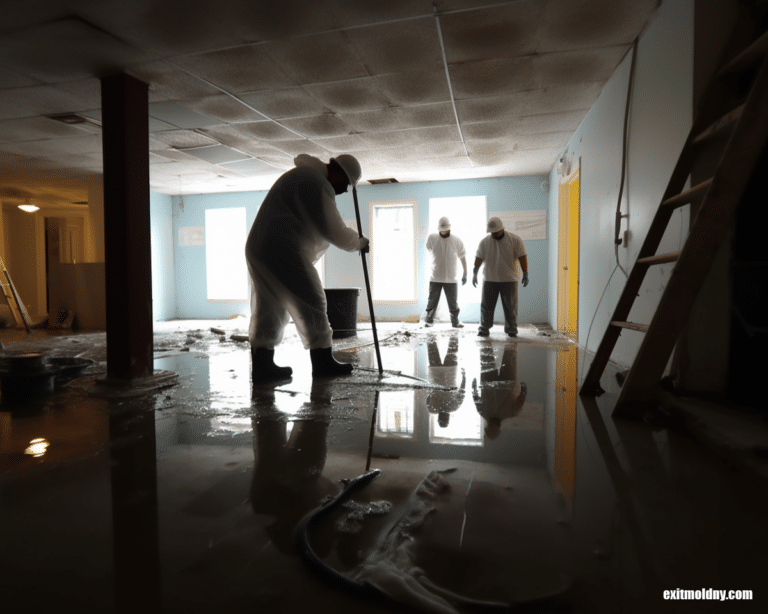
NYC landlords, business building owners, homeowners, or renters should keep the following critical facts in mind when faced with a flood in a home or business:
Stopping the source of flood. If the source of flood water is caused by a burst pipe, water heater, or overflowed toilet, contact a licensed plumber ASAP. Shut off the main water valve if one can, before the licensed plumber arrives.
Turn off the electrical breaker. Electrical sockets, appliances and flood waters do not mix. If it is possible to turn off the electrical breaker without standing or walking through water, the homeowner, building owner, superintendent, or landlord should do so. Call a licensed electrician if the homeowner, building owner, superintendent, or landlord cannot turn off the electrical breaker safely!
Call The Insurance Company. An insurance adjuster will come to examine and assess the damage and determine if the homeowner insurance policy covers such damage. If the insurance company covers the damages, it will help pay flood cleanup costs.
Document Damage. Take photos of every damaged item before a flood cleanup begins, during flood cleaning, and after the flood cleanup for the insurance company adjuster and home restoration contractor, who will need to see the areas damaged by water.
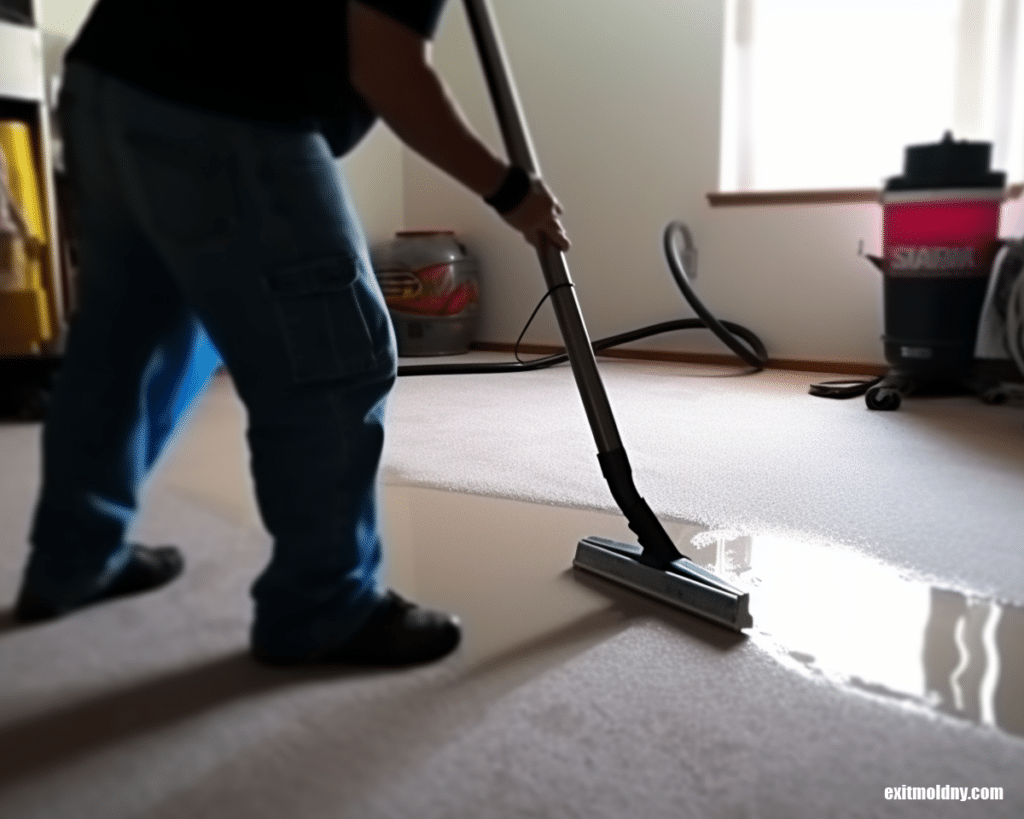
The following process of flood aftermath cleaning is what clients of Exit Mold can expect:
Inspection: An assessment of the flood damage.
This inspection involves looking for the signs of water damage: water stains on walls and floors, sagging or soft floors, cracks on the ceiling or walls, peeling or bubbling paint, musty odors, and warped wooden beams. An inspection also includes, if necessary, identifying the reason for the water damage, ensuring the flow of water has been stopped, as well as examining water for the degree of contamination, if any. Overflowed tubs, sinks, broken or leaking pipes, or water heaters have little to no contamination. A dishwasher or washing machine overflow sporting gray water may have some contaminants and blackish water caused by natural flood waters seeping into the house, or an overflowed toilet may contain hazardous sewage contaminants. The last step is determining the type of material damaged: porous material as with a carpet, fiber-fill insulation, concrete masonry, textiles, or gypsum board. This determination is necessary to know the extent of drying and dehumidification needed.
Extraction: Restoration of the home to its original condition requires extracting stagnant water. This flood cleaning involves the use of industrial vacuums and sump pumps. After the bulk of stagnant water has been extracted, any remaining water can be removed using portable wet/dry vacuums. An infrared thermal camera can discover hidden pockets of water behind walls or under floorboards.
Dehumidification: The next step of the flood aftermath cleaning process includes drying or dehumidification. This process uses heavy-duty fans, air movers, and industrial dehumidifiers. The opening of doors and windows is also done to increase air circulation. Dehumidification takes longer than extraction if water damage is extensive and may require the removal of walls or floors.
Sanitation: Killing mold after a flood requires cleaning and sanitizing. A High-Efficiency Particulate Air (HEPA) vacuum and air scrubber are used, and perhaps a ‘negative air’ machine providing a vacuum effect to remove contaminated air from a sealed duct to limit the spread of contaminants. Depending on the degree of water damage, all surfaces will need sanitizing with an anti-microbial solution. The home restoration technician wears protective clothing in this phase of cleanup after a flood, including an N95 mask, gloves, goggles, rubber boots, protective overalls, or disposable clothing.
Reconstruction: The final step of cleaning up after a flood is the reconstruction phase. In this phase, damaged items are determined to be salvageable or not salvageable. Exit Mold technicians are trained to clean, repair, and restore if an item can be salvaged. The reconstruction phase includes ‘building back’ structural items such as electrical wiring, plumbing pipes, drywall, windows, doors, and wood trim.
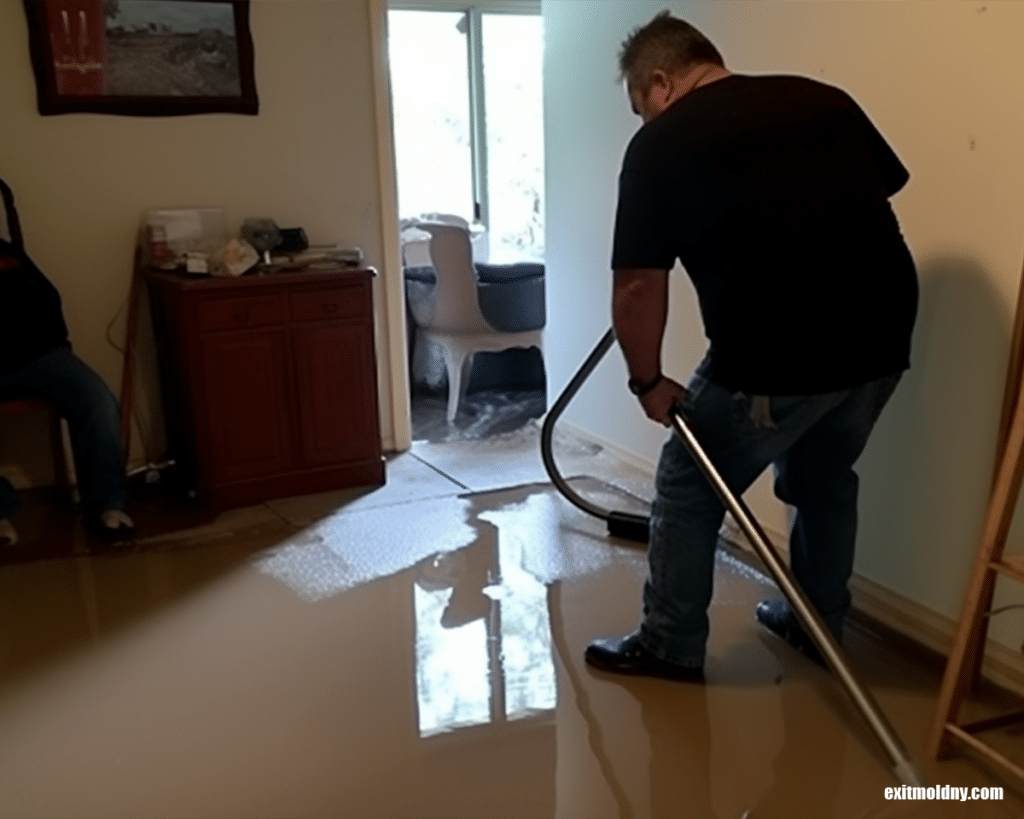
The Exit Mold family hopes today’s blog, detailing how to navigate the cleanup of the flood waters of a home or business, has eased the mind. Do not hesitate to contact us with any concerns or questions regarding our home restoration services: mold remediation, lead services, XRF lead testing, fire and smoke damage restoration, or flood and water damage restoration.

Restoring Your Home: Repairs and Renovations In our blog, A Comprehensive Guide To Cleaning Up After A Flood, we wrote about physically cleaning a home

Post Flood Cleanup: A Step-By-Step Guide It’s finally over! The dark clouds have cleared up, there’s blue sky ‘up yonder,’ and the rays of the
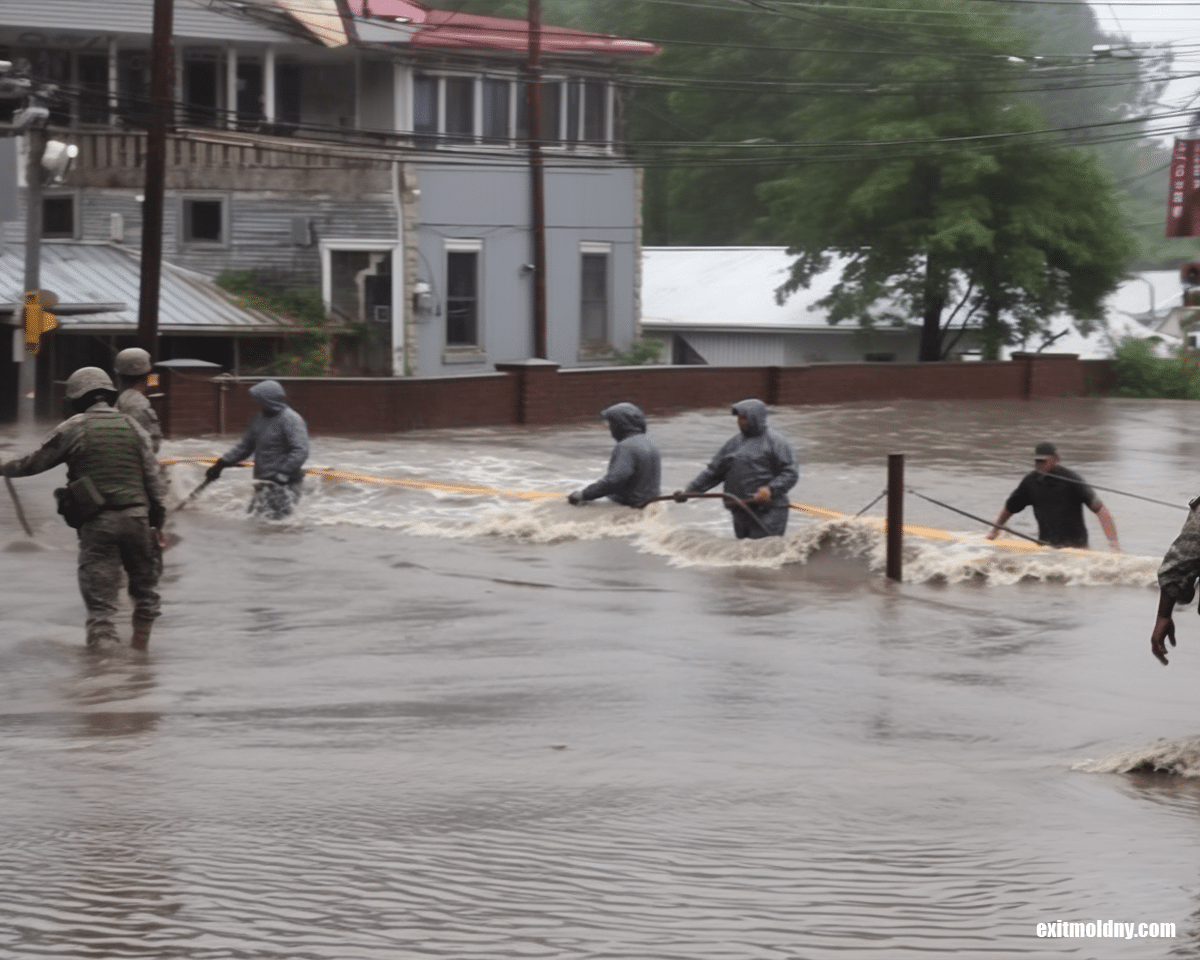
Emergency Response: What To Do During A Flood While we at Exit Mold, a New York home restoration firm serving NYC and the five boroughs



New York 5 Boroughs Area
10 Brower Ave.
Woodmere, NY 11598
(516) 512-7877
Miami Dade County Area
2509 N Miami Ave
Miami Fl 33127
(786) 465-2300
